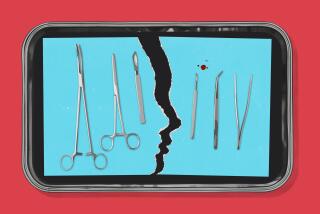9-year-old boy with rare disease now has engineered skin covering 80% of his body
For a soccer-playing, holiday-loving boy on the brink of death from a rare inherited skin disease, doctors have accomplished a feat of genetic engineering, surgical stamina and raw nerve.
Infections arising from blisters and sores had destroyed 60% of his skin. Just 7 years old when he arrived at a burn unit in Bochum, Germany, the child was in excruciating pain despite round-the-clock morphine. He suffers from junctional epidermolysis bullosa, or JEB, a disorder that is generally fatal in the first few years of life. Though the boy had outlived most with the disease, he clearly appeared that he was about to die.
A team of German and Italian physicians had a bold idea to spare him that grim fate.
Over a five-month period in the fall and winter of 2015, they harvested some of the boy’s few remaining healthy skin cells.
Using a virus to invade the cells, they introduced a corrected version of the mutated gene that had caused the catastrophic failure of his epidermis, the body’s largest organ.
They cultured the corrected cells and, on sheets backed with plastic and a naturally occurring adhesive, used them to build many square meters of healthy new epidermis.
Then, ever so delicately, they clothed his small body in a new set of skin.
More than two years after being admitted to a burn unit of the Ruhr University Children’s Hospital, the 9-year-old boy has downy hairs pushing through his smooth skin. He runs and plays with other children, gets bruises and blisters that heal normally, and needs no drugs or daily ointments to protect or preserve his transplanted outer layer of cells.
A report on his cutting-edge treatment was published Wednesday by the journal Nature.
For some of the roughly half a million children worldwide afflicted with JEB, the report brings real hope. A pioneering therapy could extend survival beyond the first few years of life, and might even restore normal skin function in some.
The medical team acknowledged that the kind of aggressive transplantation pulled off here would probably be “unthinkable” for most patients with JEB and other genetic diseases that knock out proteins key to skin’s health. After all, doctors covered roughly 80% of his body in new skin grafts.
But many young patients, they wrote, could start earlier than this patient did, getting “progressive replacement” of diseased skin in less invasive surgeries, and see their skin regenerate.
“This approach would be optimal for newly diagnosed patients early in their childhood,” the report authors wrote.
For a much broader population of patients — including those with grievous burns, diabetic ulcers and chemical injuries — the work offers new insights into how the skin can, with help, repair itself.
The virus used in this version of gene therapy proved safe, and the telltale marks it left behind in corrected cells allowed researchers to track precisely where those cells established themselves and what role they played in the patient’s recovery.
A newly identified population of stem cells, called holoclones, now lives among the child’s genetically corrected skin cells, said Dr. Michele de Luca of the University of Modena and Reggio Emilia’s Center for Regenerative Medicine, who led the team’s efforts. The activity of those cells over the last two years suggests that they will oversee the production of a continuous supply of healthy new cells to heal this young patient’s wounds and replace his sloughed-off skin.
“We think the graft will stay forever,” De Luca said. “This is going to be a stable situation.”
The young patient will continue to be vulnerable to ulcers, lesions, infections and even cancers of epithelial tissue inside his mouth and other internal body parts, where corrected skin grafts were not possible. But De Luca said many of those lesions are more manageable than are those on the body’s exterior.
The report drew praise from researchers and clinicians who work in obscurity to help patients with inherited skin disorders.
“What the whole field is aiming for is, we’d like to get younger and younger patients and replace larger and larger amounts of their skin,” said Dr. M. Peter Marinkovich, a Stanford University dermatologist who has used smaller genetically corrected skin grafts to treat a related skin disorder, dystrophic epidermolysis bullosa.
“This is the future, this is achievable,” he said. “This type of widespread replacement of a patient’s skin is feasible, and it can transform a patient’s life.”
Angela Christiano, a professor of dermatology at Columbia University in New York who studies genetic diseases of the skin, said the De Luca team’s success offers a “transformative approach” to treating young patients with JEB and related conditions, which are estimated to affect more than 125,000 people in the United States.
Christiano added that the insights generated by what she called a “landmark paper” also will help a much larger patient population whose skin problems go much deeper and may not be helped by a transplant.
That includes some of the 40,000 people hospitalized with burns in the U.S. each year. Many burn victims suffer damage to the skin’s deepest layers and cannot accept skin grafts without scarring.
“In a broader sense, for any epithelial tissue, it gives us a window into the cell behavior and how these cells behave after injury,” she said. “It suggests things we can do to take advantage of that knowledge for wound healing.”
MORE IN SCIENCE
Over-the-counter painkillers treated painful injuries just as well as opioids in new study
If you enjoy sleeping at night instead of the day, thank the dinosaurs for going extinct
Gun injuries in the U.S. have become more severe since the 1990s, study says







